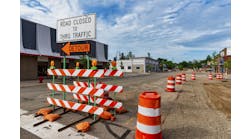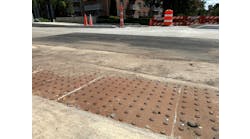Located on the shores of the St. Clair River, the downtown area of Port Huron, Mich., is divided by the Black River, and three closely spaced bascule bridges link the north and south shores. The next bridge over the Black River is located about five miles inland.
Getting around in Port Huron can be a challenge, particularly in the summer months. Recreational boats make up a high percentage of the river traffic, and the bascule bridges are raised roughly on the 1/2 hour during the peak summer days. The most active bascule bridge, Military Street, is on a state highway carrying 19,000 vehicles a day, and on the average day there are 25 bridge events (raising and lowering). Two other bascule bridges, 7th Street and 10th Street, are under the jurisdiction of the city. Each bridge event lasts about six minutes and can create a significant amount of traffic congestion, especially during the summer tourist season. City police and fire services also are impacted during the boating season.
The city of Port Huron staff recognized the challenges of traffic control with the bascule bridges, and successfully submitted an application for Congestion Mitigation and Air Quality (CMAQ) funding of a traffic signal modernization and interconnect project. The goals of the project are to reduce traffic congestion related to the bridge events and to reduce city emergency service response times.
The city developed a consultant request for proposals to define the scope of the project. URS Corp., Grand Rapids, Mich., was selected to design the traffic signal system comprising 21 traffic signal installations, optimize the traffic signal timings and provide limited construction inspection services.
Project opportunities
There were several key opportunities to effectively divert traffic and emergency vehicles from one bridge to another upon a bridge raising. The project took advantage of the following:
* The city had a licensed radio frequency available, which was desirable to provide communications for the traffic signal system;
* The Municipal Office Center is centrally located in the city, providing a potential broadcast point for the wireless communications system to serve both sides of the river. The Municipal Office Center also was the logical location for the central computer that operated and monitored the traffic signal system; and
* The street configuration of the downtown area allows for efficient traffic diversion, minimizing the travel time and distance needed to bypass a raised bridge to use an available bridge.
ITS applications
Several types of information would reduce motorist delay and emergency response times, all utilizing the traffic signal system as a communications link. The intelligent transportation systems applications are as follows:
[if !supportEmptyParas] [endif]
* Fire station: The fire station, located on the north bank of the Black River, would benefit from knowing when a bascule bridge is raised so that fire trucks do not travel toward a closed bridge. A light panel by the garage door in the fire station representing the three bridges will notify fire personnel about the status of the bridges. The light panel is automatically activated by the bascule bridge raising sequence;
* Police dispatch: The police dispatch office, located in the Municipal Office Center, would benefit from knowing when a bascule bridge is raised so that emergency vehicles do not travel toward a closed bridge. A light panel in the police dispatch office representing the three bridges will notify police dispatch about the status of the bridges;
* Bascule bridge houses: The bascule bridge houses would benefit from knowing when a fire truck has just left the fire station so that a bridge is not raised immediately prior to a fire truck's arrival at a bridge. An indicator light was added to the three bridge houses so that the bridge operators would be forewarned of an approaching fire truck; and
* Signal timing modifications during bridge openings: Traffic signal timings at intersections surrounding the bascule bridges will change during a bridge event in order to facilitate the natural flow of traffic away from the bridge out of service. Motorist information may be added at a later time using dynamic message signs or static signs with flashers.
Design issues
In the design phase of the project, several issues were addressed that impacted the effectiveness and reliability of the traffic signal operations, now and in the future. The most significant issues were as follows:
* With the modernized traffic signal installations, the traffic signals were arranged in a box configuration, which is a deviation from the typical diagonal configuration usually found in Michigan. The box configuration provides greater visibility to motorists and ease of maintenance;
* The wireless communications system serving the traffic signal system must be reliable and isolated from interference, since police dispatch and emergency response services are dependent on the information transmitted by the traffic signal system. The licensed frequency already owned by the city mitigated this issue;
* Although the city's traffic signal system and the MDOT traffic signal system are located in the same general area, using a common master controller to govern both traffic signal systems was not desired. However, the two traffic signal systems can be synchronized so that they will operate in a manner similar to having a common master controller; and
* The underground handholes supporting the traffic signal installations were sized properly to support a future upgrade to fiber-optic communications, if desired.
Construction phase
City staff provided contract administration and day-to-day inspection during construction, with URS providing technical assistance. The city's master electrician programmed the traffic controllers in accordance with URS timing plans. Construction will be completed by the end of 2003.
The total project cost was approximately $1.2 million, and the city of Port Huron received a CMAQ grant totaling $925,000. The contractor bid for the project was $998,000. This included 17 traffic signal installation modernizations, communications upgrades to four existing traffic signal installations, a computer workstation with traffic signal control software and communication links to 21 traffic signals, three bridge houses, one fire station and the Municipal Office Center.
The traffic signal timings at the intersections surrounding the Black River will change upon a bridge raising event to accommodate traffic diverting from the path toward the raised bridge.
The licensed frequency will be used for the wireless traffic signal communications system. The traffic signal system also can accommodate a future opportunity to actively assist motorists by providing bridge status information via dynamic message signs or static signs with flashers.


